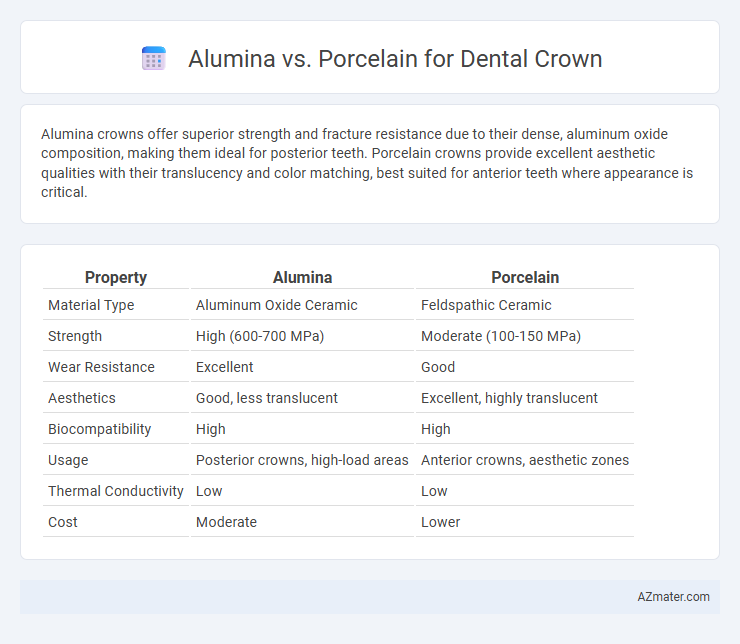Alumina crowns offer superior strength and fracture resistance due to their dense, aluminum oxide composition, making them ideal for posterior teeth. Porcelain crowns provide excellent aesthetic qualities with their translucency and color matching, best suited for anterior teeth where appearance is critical.
Table of Comparison
| Property | Alumina | Porcelain |
|---|---|---|
| Material Type | Aluminum Oxide Ceramic | Feldspathic Ceramic |
| Strength | High (600-700 MPa) | Moderate (100-150 MPa) |
| Wear Resistance | Excellent | Good |
| Aesthetics | Good, less translucent | Excellent, highly translucent |
| Biocompatibility | High | High |
| Usage | Posterior crowns, high-load areas | Anterior crowns, aesthetic zones |
| Thermal Conductivity | Low | Low |
| Cost | Moderate | Lower |
Introduction to Dental Crown Materials
Alumina and porcelain are prominent materials used in dental crowns, each offering distinct properties for restoration. Alumina crowns provide high strength and durability due to their oxide ceramic composition, making them suitable for posterior teeth subjected to heavy chewing forces. Porcelain crowns, known for their excellent esthetics and natural translucency, are commonly preferred for anterior teeth where visual appeal is critical.
Overview of Alumina Crowns
Alumina dental crowns are fabricated from aluminum oxide, prized for their excellent biocompatibility and high fracture toughness, making them suitable for patients with metal allergies. These crowns offer superior translucency compared to traditional metals, providing a more natural tooth appearance especially in the anterior region. Their durability and resistance to wear position alumina crowns as a reliable option for long-lasting dental restorations.
Overview of Porcelain Crowns
Porcelain crowns are highly favored in dental restorations due to their natural tooth-like appearance and exceptional esthetic qualities. They provide excellent durability and biocompatibility, making them suitable for both anterior and posterior teeth. Porcelain crowns are often chosen over alumina crowns for their superior translucency and ability to blend seamlessly with surrounding natural teeth.
Strength and Durability Comparison
Alumina dental crowns exhibit superior strength with a fracture toughness of approximately 4 MPa*m^0.5, making them highly resistant to chipping and cracking during mastication. Porcelain crowns, while offering excellent aesthetics due to their translucency, tend to have lower fracture toughness around 1-2 MPa*m^0.5, resulting in increased susceptibility to fractures over time. Durability studies indicate that alumina crowns maintain structural integrity longer under repetitive occlusal forces, enhancing their suitability for posterior restorations where mechanical stress is higher.
Aesthetics and Natural Appearance
Alumina dental crowns offer superior translucency and mimic the natural enamel's light-reflecting properties, providing an exceptionally realistic appearance. Porcelain crowns excel in color matching and can be custom-shaded to blend seamlessly with surrounding teeth, enhancing overall dental aesthetics. Both materials are highly biocompatible, but alumina's strength combined with its aesthetic quality makes it ideal for front teeth restorations where natural appearance is critical.
Biocompatibility and Oral Health Impact
Alumina crowns exhibit excellent biocompatibility with minimal allergic reactions, promoting healthy gum tissue and reduced plaque accumulation. Porcelain crowns, particularly porcelain-fused-to-metal, may cause slight gum irritation or sensitivity in some patients but generally support stable oral tissue health. Both materials resist bacterial colonization effectively, but alumina's superior bioinert properties enhance long-term oral health outcomes.
Cost Differences: Alumina vs Porcelain
Alumina dental crowns typically cost more than porcelain crowns due to their superior strength and durability, with prices ranging from $800 to $1,500 per crown compared to $500 to $1,200 for porcelain. The higher expense of alumina is attributed to advanced manufacturing processes and enhanced biocompatibility, making it a preferred choice for patients needing long-lasting restorations. Porcelain crowns offer a more affordable option with excellent aesthetics but may require more frequent replacement, influencing overall cost-effectiveness.
Clinical Performance and Longevity
Alumina crowns exhibit high fracture resistance and biocompatibility, making them suitable for patients with moderate occlusal stress, while porcelain crowns offer superior esthetics due to their translucency and color match with natural teeth. Clinical studies show alumina crowns have excellent longevity, often lasting over 10 years in posterior restorations, whereas porcelain crowns are preferred for anterior teeth but may be prone to chipping under heavy biting forces. Both materials require proper case selection and occlusal adjustment to maximize clinical performance and durability in dental restorations.
Indications and Best Use Cases
Alumina crowns are ideal for patients seeking high strength combined with biocompatibility, often used for posterior teeth where durability under chewing forces is critical. Porcelain crowns excel in aesthetic applications, making them the best choice for anterior teeth due to their superior translucency and ability to mimic natural enamel. Clinical indications favor alumina for cases requiring metal-free restorations with robust core support, while porcelain is preferred for visible areas demanding optimal cosmetic outcomes.
Patient Satisfaction and Reviews
Patient satisfaction with alumina dental crowns is often praised for their excellent biocompatibility and natural appearance, leading to fewer allergic reactions and higher comfort levels. Porcelain crowns receive positive reviews for their superior aesthetic qualities, closely mimicking natural tooth translucency and color, which enhances patient confidence in smile restoration. Studies show alumina crowns provide durability and reduced wear on opposing teeth, while porcelain's appeal lies in its customized fit and stain resistance, influencing patient preferences based on individual needs.

Infographic: Alumina vs Porcelain for Dental crown
 azmater.com
azmater.com